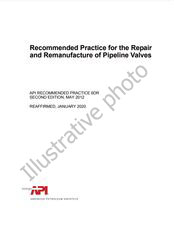We need your consent to use the individual data so that you can see information about your interests, among other things. Click "OK" to give your consent.

API PUBL 4694-ed.1999
Laboratory Analysis of Petroleum Industry Wastewaters Arranging for Analysis and Understanding Laboratory Reports
Translate name
STANDARD published on 1.12.1999
The information about the standard:
Designation standards: API PUBL 4694-ed.1999
Publication date standards: 1.12.1999
SKU: NS-1139856
The number of pages: 165
Approximate weight : 526 g (1.16 lbs)
Country: American technical standard
Category: Technical standards API
Annotation of standard text API PUBL 4694-ed.1999 :
API PUBL 4694, 1999 Edition, December 1999 - Laboratory Analysis of Petroleum Industry Wastewaters Arranging for Analysis and Understanding Laboratory Reports
This manual is designed for environmental coordinators, managers, corporate staff, and others who must address environmental compliance reporting and regulatory issues. It is also useful for field personnel responsible for obtaining wastewater sample analyses to fulfill environmental regulatory requirements.
This manual assumes that users have some familiarity with wastewaters in the petroleum industry and with the basic requirements of wastewater permits. It is helpful if users also have some basic knowledge of wastewater constituents, analytical methods, analytical laboratories, and environmental regulatory agencies.
Types of Wastewaters Covered
This manual addresses wastewaters associated with the petroleum industry? including:
- 1) Petroleum refining
- • Treated process effluent for direct discharge,
- • Pretreated process effluent for indirect discharge (for example, to a
- • Storm water.
- 2) Marketing and pipeline terminals
- • Treated process effluent for direct discharge,
- • Pretreated process effluent for indirect discharge,
- • Storm waters, and
- • Untreated process wastewater such as tank water draws.
- 3) Underground storage tank cleanups
- • Leaks and spills to ground water.
- 4) Petroleum production facilities
- • Produced water from crude oil extraction.
Most of these wastewaters are direct or indirect point source discharges to surface waters, which are regulated under the U. S. Environmental Protection Agencys (EPAs) National Pollutant Discharge Elimination System (NPDES) under authority of EPA or an NPDES-authorized state. Thus, most of the discussion and examples in this manual relate to the NPDES program.
Purpose of This Manual
The purpose of this manual is to help the user:
Understand the technical and regulatory issues associated with obtaining analytical data on wastewater samples as well as the interpretation of the data.
Understand data quality objectives (DQOs) and articulate DQOs at the beginning of a project.
Select analytical methods and evaluate their pros and cons.
Understand and specify method detection limits, quantification limits, reporting levels, minimum levels, and other related terms.
Understand the concepts of laboratory QA/QC and be able to specify, request, and interpret QNQC data such as spikes, duplicates, and blanks.
Understand how matrix interference affects analyses and how to work with the laboratory to resolve such problems.
Evaluate and select a laboratory.
Review laboratory reports.
Understand what to do if a QNQC requirement is failed.
Whats in This Manual
This manual contains information on two levels. Part I is designed to provide the most critical information in a simple format that can be read quickly. Checklists for various topics based on the information in Part I have been developed for practical use and are found in Part IV. Part II of the manual contains additional detail on the topics discussed in Part I, as well as other related topics. Part III of the manual includes references and acronyms. Examples of case studies, laboratory reports, and data calculations are given throughout the manual.
Users of this manual who need information very quickly about a particular topic should go to Quick Start at the end of this Introduction. For other users who have less pressing needs, the following outline gives a brief overview of each chapter in the manual.
We recommend:
Technical standards updating
Do you want to make sure you use only the valid technical standards?
We can offer you a solution which will provide you a monthly overview concerning the updating of standards which you use.
Would you like to know more? Look at this page.



 Cookies
Cookies
